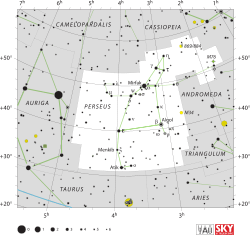Psi Persei

| |
| Observation data Epoch J2000 Equinox J2000 | |
|---|---|
| Constellation | Perseus |
| Right ascension | 03h 36m 29.37982s[1] |
| Declination | +48° 11′ 33.4789″[1] |
| Apparent magnitude (V) | 4.310[2] |
| Characteristics | |
| Spectral type | B5Ve[3] |
| U−B color index | −0.56[4] |
| B−V color index | −0.06[4] |
| Variable type | γ Cas[5] |
| Astrometry | |
| Radial velocity (Rv) | −1.1[6] km/s |
| Proper motion (μ) | RA: +22.55[1] mas/yr Dec.: −27.78[1] mas/yr |
| Parallax (π) | 5.59 ± 0.22[1] mas |
| Distance | 580 ± 20 ly (179 ± 7 pc) |
| Details | |
| Radius | 4.7 ± 0.3[7] R☉ |
| Surface gravity (log g) | 4.0[8] cgs |
| Temperature | 16,053 ± 447[8] K |
| Rotational velocity (v sin i) | 390[9] km/s |
| Other designations | |
Psi Persei (Psi Per, ψ Persei, ψ Per) is a Be star in the northern constellation of Perseus. It has an apparent visual magnitude of 4.31,[2] so it is visible to the naked eye at night under suitably dark skies. Based on parallax measurements, it is located at a distance of roughly 580 light-years (180 parsecs) from the Earth.[1]
This star has a stellar classification of B5Ve,[3] which indicates it is a B-type main sequence star that is generating energy at its core through the nuclear fusion of hydrogen. It is a shell star with a circumstellar disc of gas surrounding the equator and extending out to about 11 times the radius of the star.[7] As a result of this disc, the spectrum of this star shows emission lines (as indicated by the 'e' in the stellar class) and its magnitude varies over a period of about a day.[5]
Psi Persei is rotating rapidly with a projected rotational velocity (v sin i) along the equator of 390 km/s or more.[9] The axis of rotation is inclined about 75° ± 8° to the line of sight from the Earth, so this velocity is close to the actual azimuthal velocity along the star's equator. It is expelling mass at the rate of about 5.0 × 10−8 times the mass of the Sun per year, or the equivalent of the Sun's mass every 20 million years.[7] This star may be a member of the Alpha Persei Cluster, although its proper motion is high compared to other members.[10]
Name and etymology
- This star, together with δ Per, σ Per, α Per, γ Per and η Per, has been called the Segment of Perseus.[11]
- In Chinese, 天船 (Tiān Chuán), meaning Celestial Boat, refers to an asterism consisting of ψ Persei, η Persei, α Persei, γ Persei, δ Persei, 48 Persei, μ Persei and HD 27084. Consequently, ψ Persei itself is known as 天船四 (Tiān Chuán sì, English: the Fourth Star of Celestial Boat.)[12]
References
- ↑ 1.0 1.1 1.2 1.3 1.4 1.5 van Leeuwen, F. (November 2007), "Validation of the new Hipparcos reduction", Astronomy and Astrophysics 474 (2): 653–664, arXiv:0708.1752, Bibcode:2007A&A...474..653V, doi:10.1051/0004-6361:20078357
- ↑ 2.0 2.1 2.2 "psi Per -- Be Star". SIMBAD. Centre de Données astronomiques de Strasbourg. Retrieved 2011-02-24.
- ↑ 3.0 3.1 Lesh, Janet Rountree (December 1968). "The Kinematics of the Gould Belt: an Expanding Group?". Astrophysical Journal Supplement 17: 371. Bibcode:1968ApJS...17..371L. doi:10.1086/190179.
- ↑ 4.0 4.1 Johnson, H. L. et al. (1966). "UBVRIJKL photometry of the bright stars". Communications of the Lunar and Planetary Laboratory 4 (99). Bibcode:1966CoLPL...4...99J.
- ↑ 5.0 5.1 Percy, John R.; Ivans, Inese I.; Fried, Robert E.; Paparo, Margit (February 1994). "Short-term photometric variability of Psi Persei and Zeta Tauri". Publications of the Astronomical Society of the Pacific 106 (696): 131–133. Bibcode:1994PASP..106..131P. doi:10.1086/133356.
- ↑ Evans, D. S. (June 20–24, 1966). "The Revision of the General Catalogue of Radial Velocities". In Batten, Alan Henry; Heard, John Frederick. Determination of Radial Velocities and their Applications, Proceedings from IAU Symposium no. 30. University of Toronto: International Astronomical Union (published 1967). pp. 57–63. Bibcode:1967IAUS...30...57E.
- ↑ 7.0 7.1 7.2 Delaa, O. et al. (May 2011), "Kinematics and geometrical study of the Be stars 48 Persei and ψ Persei with the VEGA/CHARA interferometer", Astronomy & Astrophysics 529: A87, Bibcode:2011A&A...529A..87D, doi:10.1051/0004-6361/201015639
- ↑ 8.0 8.1 Underhill, A. B. et al. (November 1979), "Effective temperatures, angular diameters, distances and linear radii for 160 O and B stars", Monthly Notices of the Royal Astronomical Society 189: 601–605, Bibcode:1979MNRAS.189..601U, doi:10.1093/mnras/189.3.601
- ↑ 9.0 9.1 Bernacca, P. L.; Perinotto, M. (1970). "A Catalogue of Stellar Rotational Velocities". Contributi Osservatorio Astronomico di Padova in Asiago 239 (1). Bibcode:1970CoAsi.239....1B.
- ↑ Morrell, Nidia; Abt, Helmut A. (July 10, 1992). "Spectroscopic binaries in the Alpha Persei cluster". Astrophysical Journal, Part 1 393 (2): 666–673. Bibcode:1992ApJ...393..666M. doi:10.1086/171534.
- ↑ Allen, R. H. (1963). Star Names: Their Lore and Meaning (Reprint ed.). New York: Dover Publications Inc. p. 331. ISBN 0-486-21079-0. Retrieved 2012-09-04.
- ↑ (Chinese) AEEA (Activities of Exhibition and Education in Astronomy) 天文教育資訊網 2006 年 7 月 11 日
| ||||||||||||||||||||||||||||||||||